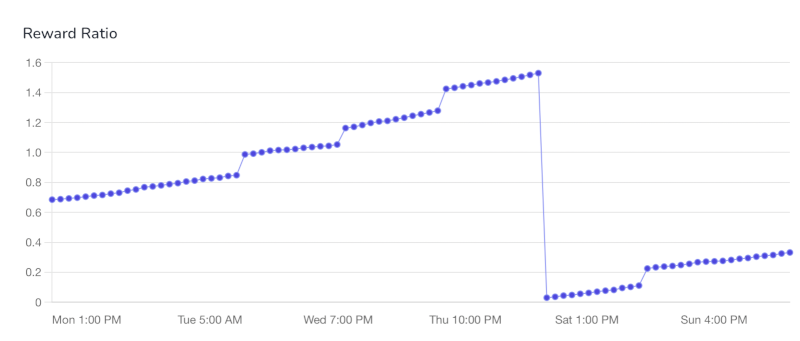Vote Delegation Reward Rate Explained | Songbird Network
One number everyone's talking about is the "Reward Rate" - It's a number that needs further explanation.
If you're not familiar with it, it's here on FlareMetrics, along with a growing list of metrics used to track signal providers performance on the Songbird network.
So what is it? It's a ratio used to calculate how many tokens you'll receive per 100 delegated.
Why is it displaying lower than last epoch? The Reward Rate resets each epoch, as the variables that are used to calculate it have changed.
When the voting delegation lock occurs, a snapshot of your token balance is taken, along with the signal providers you've selected and the percentage in which you've delegated to each.
This is now known by the network and stored for later use, when it comes time to allocate your rewards.
This snapshot also provides us with the signal providers' total vote power (all delegators votes combined) for that epoch.

A sample graph showing the Reward Rate of a signal provider from one epoch to the next.
Saturday, at 08:41 UTC, when the new rewards epoch begins, each signal provider submits and then reveals their pricing submissions, approximately every 4 minutes. The successful outcome of these submissions results in rewards being earned by the signal provider.
You can find a detailed explanation on how the FTSO works and a more in depth explanation of the voting rounds here.
These voting rounds are the unknown, they evolve over the duration of the epoch. As voting rounds are won (or shared) by a provider, the provider earns rewards. These rewards grow and form the pool in which delegators are paid.
To offer up an analogy, as provided by a member of the community;
There's a tall, cylindrical, glass container for each Signal Provider (SP). At the start of each epoch the container is empty. Every four minutes, a small volume of water is added to the container in proportion to the voting power that the SP has, but only if it is one of the winners of that four minute voting round. If the SP doesn't win that round, the level of water stays the same. Over the hours, the water level in most of the containers is likely to rise as most of the SP's win rounds at least occasionally. The Reward Rate that you see on FlareMetrics is the level of water in each container, not the rate at which the level is increasing (though the latter could be derived from the changes in level if one wished). The levels always increase over the week, quickly or slowly depending on the success and the voting power of the signal provider. Only at the end of the epoch can the reward rate per week for each SP be seen. Then the containers are all emptied and the filling process starts again for the next epoch.
To express this as a formula;
multiplier = 100 - fee
multiplier = multiplier / fee
provider reward rate = (multiplier * provider current rewards) / provider vote power
The result is then multiplied by 100 to better represent the number displayed.
Final Word: The Reward Rate will change over time, as more providers are added, so what happened last epoch may not happen again this epoch.
Changes to signal providers algorithms and the processes in which they make their submissions will also affect the results from epoch to epoch.
When there's more data, FlareMetrics will be able to display an overall Reward Rate for each provider, so you'll have a better understanding of how each provider has performed long term.
If you're new to Flare Networks and Songbird you might find our Getting Started index of posts and pages useful. It includes a post, Delegation Factors To Consider which is worth reading.
Other relevant posts include Connecting MetaMask Wallet For Songbird & How To Wrap, Unwrap & Delegate Songbird Tokens.
If you're having troubles, please contact us on Twitter, or Discord.